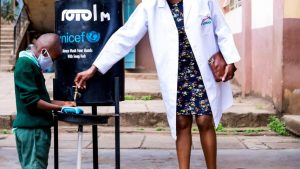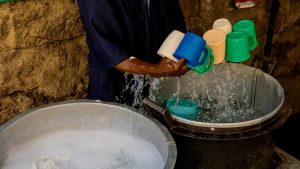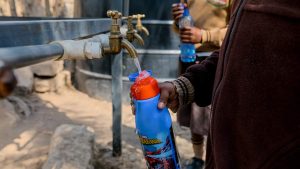In 2016, only around half of the approximately 46 million people in Kenya had access to clean drinking water and adequate sanitation. The expansion of infrastructure is not keeping pace with population growth in many of the over 2,000 poor urban areas, where around eight million people live. Only 16 per cent of the total urban population are connected to a wastewater system. Untreated household wastewater, agriculture and industry are polluting the water resources, the use of which is generally not under state control. Assigning responsibility for drinking water supply and sanitation to the 47 newly created counties that was initiated by the reform of the constitution in 2010 and enshrining the right to adequate water supply and sanitation in the constitution have resulted in major challenges for the sector. So far, only a small number of counties have been able to fulfil the population’s high expectations with regard to improving public services and combating corruption in administration.
The framework conditions for governance and corporate management of urban water services and sanitation in line with the economic situation of the poor and for sustainable management of water resources are inadequate.
Objective
The population of Kenya, particularly in areas of urban poverty, has better access to drinking water and sanitation. The management of the scarce water resources that is necessary to achieve this has improved.
Approach
With its work, the project team aims to combine the human right to drinking water and sanitation with a focus on good governance. To achieve this, the team is developing guidelines at national level – particularly for and with the Water Services Regulatory Board. It is preparing action plans with the supervisory boards of water utility companies with the aim of making decision-making processes transparent and verifiable. For example, the project is improving the water supply in poor urban areas in cooperation with the water utility companies Kericho and Oloolaiser. The partners are responsible for the operation of water kiosks and are introducing digital solutions, such as invoicing software and geographic information systems for managing pipe networks, and reducing water losses. The project is supporting the Kenyan Water Sector Trust Fund, which aims to improve the provision of water services to the poor, in developing engineering and operational solutions for drinking water supply and sanitation in poor urban areas.
The team will ensure that national ministries and authorities will benefit from the experience gained in working with the water utility companies Kericho and Oloolaiser. In cooperation with the Water Resource Management Authority, the project is also developing national standards for data management that are based on experience in individual catchment areas gained in previous projects.



